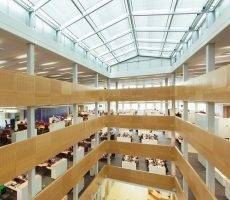 The main driver of the growing interest in wellbeing in recent years has undoubtedly been absenteeism. But workers don’t have to be ‘absent’ from the workplace to hamper productivity. Presenteeism, where employees are present but not productive can also influence the long-term success of an organisation. The interaction between the worker and their work environment has a huge influence on an individual’s wellbeing and overall productivity, with employees’ performance more likely to be enhanced when they are immersed in a comfortable and stimulating environment. This can include all the usual stipulations, such as a well-designed workstation, a comfortable office temperature and carefully considered and appropriate lighting. In fact, improved lighting is an essential element in the overall mix, not only because of the cost savings that their energy efficiency brings but also in the way lighting contributes to workplace wellbeing and people’s performance.
The main driver of the growing interest in wellbeing in recent years has undoubtedly been absenteeism. But workers don’t have to be ‘absent’ from the workplace to hamper productivity. Presenteeism, where employees are present but not productive can also influence the long-term success of an organisation. The interaction between the worker and their work environment has a huge influence on an individual’s wellbeing and overall productivity, with employees’ performance more likely to be enhanced when they are immersed in a comfortable and stimulating environment. This can include all the usual stipulations, such as a well-designed workstation, a comfortable office temperature and carefully considered and appropriate lighting. In fact, improved lighting is an essential element in the overall mix, not only because of the cost savings that their energy efficiency brings but also in the way lighting contributes to workplace wellbeing and people’s performance.
Employers increasingly recognise the duty of care they have towards their employees and a consideration of staff needs is vital for morale. Demonstrating a duty of care will undoubtedly foster a greater sense of staff satisfaction, increase motivation and productivity and lead to more staff retention. All of which ultimately drive up company profits.
The HSE advises employers on their duty of care and provides a wealth of information on how to design workplaces effectively. While it recommends that lighting should be considered principally at the design stage, it emphasises the importance of designing lighting specifically for the tasks that individuals carry out.
Poor lighting, for instance, will almost undoubtedly have a detrimental effect on an individual’s ability to perform tasks. Evidence also strongly suggests that it can contribute to depression (especially in the winter months) and can even lower productivity.
On the plus side, appropriate and suitable lighting has many positive benefits, particularly where employees are fully engaged in the process. According to the HSE, studies have shown that giving workers in open plan offices control of lighting can increase job satisfaction and, at the same time, decrease stress.
Indeed, a growing body of research underlines this important link between lighting and wellbeing. Lighting for People, a research paper that was produced as part of the European Union’s programme for research and technological development, has drawn together a wealth of research to demonstrate just how important lighting is on human health and wellbeing.
For instance, Karin CHJ Smolders and Domien GM Beersma from the Department of Chronobiology at the University of Groningen in the Netherlands report that: “Workplace lighting can, in addition to providing sufficient light to conduct work-related visual tasks, affect employees’ alertness, mood, cognition, sleep-wake pattern and health.”
One of the most important points to make here is that lighting covers both artificial lighting and natural daylight. As such, a key consideration in any lighting scheme design is the need to ensure that there is an optimum balance between the two.
Interestingly, the introduction of smart lighting has made it much easier to achieve this delicate, yet essential, balance. This enables the use of sensors and control technology to automatically adjust the ambient light levels.
Even so, facilities managers must not consider lighting levels alone. An effective lighting scheme should also take into account lighting intensity, its colour spectrum and timing. Light intensity, for example, has been shown to affect how employees feel about their work environment.
This move towards more human-centric lighting or biodynamic lighting is already underway. By using the latest LED technology, facilities managers can control and adapt the content, intensity, duration and timing of lighting during the day to match circadian rhythms.
Some researchers suggest that future lighting schemes should be much smarter in their design and application. We should be taking into account not just the amount of lumens emitted by a light, but also whether or not the lighting affects workers positively by promoting a healthy environment.
The biggest challenge perhaps is designing appropriate lighting systems for night-time workers. The past decade has seen a significant growth in night-shift work but installing high-intensity lighting is definitely not the solution. In fact, scientists warn that interfering with melatonin production can negatively impact on long-term health.
Facilities managers also need to consider that the UK workforce is ageing and that age, together with gender and genes, has an important bearing on how sleep-wake regulation works. As we get older, our vision reduces as does the body’s ability to take in light. Therefore, biodynamic lighting has a vital role to play in the future workplace.
As a general starting point, my advice would be to commission lighting so that it complements the working patterns and different tasks undertaken in particular areas of a building. It’s also important to ensure that there is employee buy-in during the design process as this will create a sense of empowerment.
The history of lighting in the workplace is a fascinating one. At the outset, arguably it was all about making the workplace safe for employees. In more recent years, businesses have also recognised that smart lighting can lead to significant energy savings. The spotlight now is increasingly on human health and wellbeing and how biodynamic lighting can improve productivity. It’s just a matter of time before more businesses switch on.
_________________________
 Andy Gallacher is product marketing manager for mains lighting at Eaton.
Andy Gallacher is product marketing manager for mains lighting at Eaton.














August 17, 2016
Intelligent lighting can enhance workplace wellbeing and productivity 0
by Andy Gallacher • Comment, Environment, Facilities management, Lighting, Wellbeing, Workplace design
Employers increasingly recognise the duty of care they have towards their employees and a consideration of staff needs is vital for morale. Demonstrating a duty of care will undoubtedly foster a greater sense of staff satisfaction, increase motivation and productivity and lead to more staff retention. All of which ultimately drive up company profits.
The HSE advises employers on their duty of care and provides a wealth of information on how to design workplaces effectively. While it recommends that lighting should be considered principally at the design stage, it emphasises the importance of designing lighting specifically for the tasks that individuals carry out.
Poor lighting, for instance, will almost undoubtedly have a detrimental effect on an individual’s ability to perform tasks. Evidence also strongly suggests that it can contribute to depression (especially in the winter months) and can even lower productivity.
On the plus side, appropriate and suitable lighting has many positive benefits, particularly where employees are fully engaged in the process. According to the HSE, studies have shown that giving workers in open plan offices control of lighting can increase job satisfaction and, at the same time, decrease stress.
Indeed, a growing body of research underlines this important link between lighting and wellbeing. Lighting for People, a research paper that was produced as part of the European Union’s programme for research and technological development, has drawn together a wealth of research to demonstrate just how important lighting is on human health and wellbeing.
For instance, Karin CHJ Smolders and Domien GM Beersma from the Department of Chronobiology at the University of Groningen in the Netherlands report that: “Workplace lighting can, in addition to providing sufficient light to conduct work-related visual tasks, affect employees’ alertness, mood, cognition, sleep-wake pattern and health.”
One of the most important points to make here is that lighting covers both artificial lighting and natural daylight. As such, a key consideration in any lighting scheme design is the need to ensure that there is an optimum balance between the two.
Interestingly, the introduction of smart lighting has made it much easier to achieve this delicate, yet essential, balance. This enables the use of sensors and control technology to automatically adjust the ambient light levels.
Even so, facilities managers must not consider lighting levels alone. An effective lighting scheme should also take into account lighting intensity, its colour spectrum and timing. Light intensity, for example, has been shown to affect how employees feel about their work environment.
This move towards more human-centric lighting or biodynamic lighting is already underway. By using the latest LED technology, facilities managers can control and adapt the content, intensity, duration and timing of lighting during the day to match circadian rhythms.
Some researchers suggest that future lighting schemes should be much smarter in their design and application. We should be taking into account not just the amount of lumens emitted by a light, but also whether or not the lighting affects workers positively by promoting a healthy environment.
The biggest challenge perhaps is designing appropriate lighting systems for night-time workers. The past decade has seen a significant growth in night-shift work but installing high-intensity lighting is definitely not the solution. In fact, scientists warn that interfering with melatonin production can negatively impact on long-term health.
Facilities managers also need to consider that the UK workforce is ageing and that age, together with gender and genes, has an important bearing on how sleep-wake regulation works. As we get older, our vision reduces as does the body’s ability to take in light. Therefore, biodynamic lighting has a vital role to play in the future workplace.
As a general starting point, my advice would be to commission lighting so that it complements the working patterns and different tasks undertaken in particular areas of a building. It’s also important to ensure that there is employee buy-in during the design process as this will create a sense of empowerment.
The history of lighting in the workplace is a fascinating one. At the outset, arguably it was all about making the workplace safe for employees. In more recent years, businesses have also recognised that smart lighting can lead to significant energy savings. The spotlight now is increasingly on human health and wellbeing and how biodynamic lighting can improve productivity. It’s just a matter of time before more businesses switch on.
_________________________